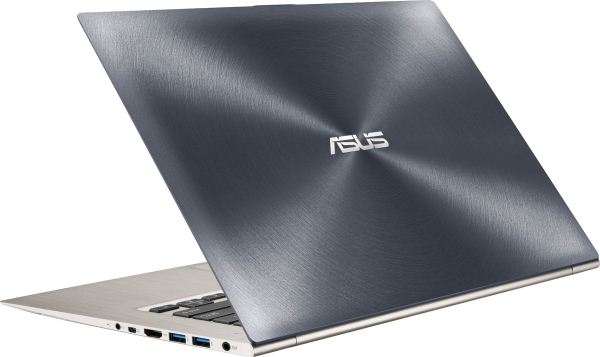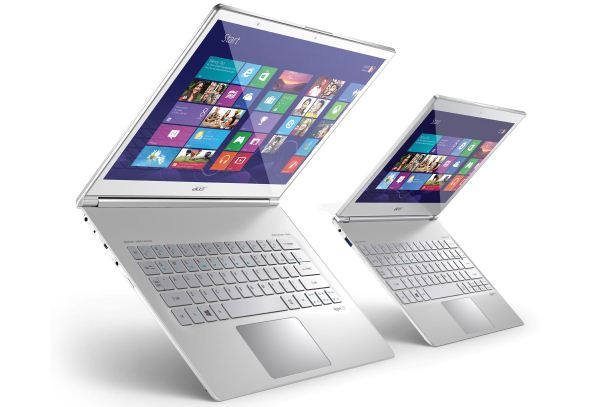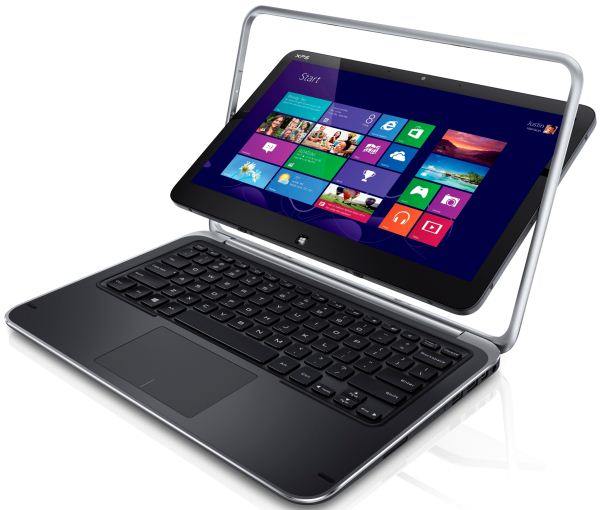Holiday 2012 Ultrabook and Ultraportable Guide
by Jarred Walton on December 12, 2012 4:00 AM ESTHigh-End Ultrabooks
Wrapping things up, we enter the final category of Ultrabooks and ultraportables, though these days we’re dealing almost exclusively with the former. In some cases we’re just getting the final high-end components from the previous category (Core i7 and 240/256GB SSDs), but there are a few other extras out there that might be worth the extra money. Let’s start with one of those.
High-End Ultrabook with Gaming Potential
The Acer M5 certainly packs a fairly potent CPU and GPU combination into an affordable package, but the overall quality of some elements is lacking. The display in particular is a sore spot, so what if you could get a similar laptop but with a 1080p IPS display? What you’d end up with is the ASUS UX32VD-DH71. It’s the big brother of the UX32A, which mostly means the display isn’t 1366x768 junk and you get a Core i7 CPU. You also get a GeForce GT 620M GPU, which actually isn’t all that fast, but it’s still probably twice the performance of the HD 4000 and you’re not as apt to throttle the CPU. Because of the design, you can also use standard 2.5” SSDs, making it possible to ditch the 500GB HDD and go for something faster. As noted earlier, Windows 8 is also shipping on the UX32VD now, so if you’re not keen on the new UI consider ClassicShell or Start8 as a good way to fix what MS broke. The UX32VD-DH71 currently sells for around $1300.
Hello 1080p Touchscreens!
At present, there are two 1080p Ultrabooks with touchscreens that I’m aware of, and we have them both in for testing. Each has some perks as well as a few quirks, so both are worthy of consideration.
Acer Aspire S7
I have to say, the first time you see the Aspire S7, you’ll very likely wonder if the Acer logo on the back isn’t a mistake. This is an extremely attractive laptop, and to my knowledge it’s the thinnest laptop anyone has ever shipped—it’s a whopping 0.47” (11.9mm) thick, which is in thick tablet territory! Acer’s 1080p display is good if not exceptional (colors are not anywhere close to accurate, though it’s at least reasonably bright), and you can go for either a Core i5-3317U with a 128GB SSD ($1300) or spend $350 more to get a Core i7-3517U with a 256GB SSD—actually, it’s technically two 64GB SSDs or two 128GB SSDs in RAID 0, which is one of the quirks. Anyway, if the $350 upsell sounds like highway robbery (it is!), we recommend the Core i5 model—95% of the performance, but with half the internal storage. One of the coolest things about both Windows 8 Ultrabooks that I’ve tested is that they can complete a full boot into the OS in about 10 seconds, and with the touchscreens the Windows 8 UI at least makes a bit of sense.
The biggest issues I have with the Aspire S7 (full review forthcoming) are the keyboard and the touchscreen. Starting with the latter, there’s no real issue as such, but reaching across the keyboard to touch the display feels a bit cumbersome. What the S7 needs is a way to turn into an actual tablet, like the Lenovo Yoga on the previous page or the Dell XPS 12 we’ll get to in a moment. You can lay the screen flat (180 degree hinge), but that’s not the same as a tablet. The keyboard is a far more irksome design, unfortunately, at least in my view. You see, I like to use keyboard shortcuts and that means using the function keys; Acer has chopped off the fifth row of keys, merging the function keys with the numbers. There are some other odd key locations as well, but the missing function keys is my biggest complaint. Given enough time I could probably adapt, but every other laptop and keyboard I use has function keys so it still frustrates me.
If Acer does a revised S7 in early 2013, changing the keyboard and creating a real tablet mode need to be at the top of their list. Pricing is also going to raise some eyebrows. I know people spend a lot of money on certain laptop brands, but those are generally business laptops or Apple products. I have a difficult time believing people will pay anywhere near $1300 for the base model S7-391, or $1200 for the 11.6” S7-191, regardless of how nice they look, simply because Acer’s brand lacks the necessary cachet.
Dell XPS 12
If you take all of the interesting points from the Acer S7 and fix the keyboard along with creating a workable tablet mode, you get the Dell XPS 12. This is actually one of the coolest laptops I’ve seen in some time, and while I was concerned about the “flip-screen” aspect holding up long-term when I first saw it, in hand the mechanism feels quite robust. Short of some abuse or an accident, the hinges feel like they’ll last many years. And that’s good, because the flip-screen is really cool. You can use the XPS 12 as a regular laptop, or you can flip the screen 180 degrees and close it, creating a tablet. One thing that’s very obvious is that the XPS 12 is quite a bit thicker than any Android or iOS tablets, but the Core i5/i7 Ivy Bridge processor at its heart is also substantially faster than any of the ARM or Atom parts we’ve seen elsewhere.
Besides the cool factor of the display, the XPS 12 comes in a variety of configurations. The base model has the 12.5" 1080p IPS panel, 4GB RAM, 128GB SSD, and an i5-3317U processor for $1200. Sadly, there’s no 8GB i5-3317U configuration, so the next step up gets you 8GB RAM and an i7-3517U for $1400—a $1250 configuration with just the 8GB RAM upgrade would have been perfect. Moving beyond that point, you can go back to the i5-3317U and get 8GB RAM, but you get a 256GB SSD, all for a starting price of $1500. Finally, there’s the no-holds-barred version that gives you the 8GB RAM, i7-3517U, and a 256GB SSD for $1700. I really like the design of the XPS 12, but the price gouging is enough to make me cry; $200 for a $25 RAM upgrade and a 100-200MHz CPU clock speed increase is laughable, and $200 to upgrade from a 128GB to a 256GB SSD is just as bad. But, if you want what is arguably the coolest Ultrabook around right now, that’s the price of entry.
Wrap-Up
This guide specifically focused on Ultrabooks and ultraportables, which eliminates a huge portion of the mobile market. We’ll look at doing other mobile guides in the coming days that get into the areas we’ve missed, including gaming laptops, other budget offerings, and even tablets. For now, we’ve listed about a dozen laptops that we could recommend for various reasons. Not every laptop would be a good fit for every person, but if you want something that’s easy to carry around—either for work, school, or some other reason—you should have several worthy options to consider. What did we miss, or do you have a converse opinion on any of our recommendations? Let us know in the comments!













77 Comments
View All Comments
mayankleoboy1 - Wednesday, December 12, 2012 - link
Ultrabooks -- Shiny Things For The Stupiddi1in - Wednesday, December 12, 2012 - link
Just because you didn't need them (or can't afford), does not mean others don't.SetiroN - Wednesday, December 12, 2012 - link
After being seduced by the hype and getting an UX31A zenbook prime, I can only agree with him.Similar performance to $400 laptops for 4 times the price with a weight and battery life that still leave something to be desired.
I'd much rather have a standard i3 (which performs better) than those overpriced ULV cpus, in a thicker laptop that takes advantage of it with a seriously hefty battery and acceptable dedicated, switchable graphics.
Shiny things for the stupid - or overly rich. Apple products in a taiwanese package.
Spending $1500 to still have absymal performance and the same kind of battery life just for the sake of some thinness is ridiculous, especially considering that they're not really all that incredibly more portable than standard 13".
karasaj - Wednesday, December 12, 2012 - link
Why would you buy an ultrabook if you need more performance and heavy graphics... there's a reason MBA and iPad's became popular, and it isn't because of their price per performance.SetiroN - Wednesday, December 12, 2012 - link
I'm not sure what post you've read, but nowhere did I say I needed more performance or heavy graphics.As most people, you read what you want to read instead of trying to understand other people's perspective.
I'll try and help you: what I said is that
there is no reason to pay 4-5 times the price just to have a fashion item, because a normal 13" with an i3 could allow for a much larger battery and a dedicated GPU (which doesn't mean a 680m as you thought, just something more acceptable than the absymal HD4000) at a fraction of the price of high end ultrabooks while maintaining similar portability; Ultrabooks aren't really all that more portable because their battery still lasts 4 hours while weight and thickness aren't lower enough to justify the price. Nor does the cheap e-IPS screens that they market as if were EIZO while in reality they just cost just a little more than TNs.
If you need your CPU to consume less power, you can configure a power profile that lets any Ivy Bridge CPU consume the same kind of low power of the overpriced ULV processors that Intel is so willing to shove down our throats.
You pay for FASHION, not real added value.
The reason MBAs and Ipads became popular is that they offer good enough performance while being STILISH, regardless of their cost.
A smart buyer that doesn't care about making an impression with their laptop would save $500 and get the same thing half an inch thicker, while improving graphics performance in the process.
Nvidiaguy07 - Wednesday, December 12, 2012 - link
Im sure i can pay much less for a big clunky piece of crap, but lugging around something like that - with many inferior parts isnt just about style.-sent from my 13" macbook air
aahjnnot - Wednesday, December 12, 2012 - link
You make the mistake of assuming that everyone is like you.Like many people, I have absolutely no interest in gaming so performance on my 13" MacBook Air is more than adequate. It launches applications instantaneously, resumes from suspend in a few seconds and is even fast enough for light video editing.
Of far more importance is the weight (it's light enough for me not to care about carrying it), the battery life (enough for an evening on the sofa), the screen quality and resolution and cool operation (my sperm don't care if it's on my lap).
If you think I bought it as a FASHION statement, you're an extraordinarily bad student of human behaviour.
Ananke - Wednesday, December 12, 2012 - link
I got $250 Asus made Pentium laptop, which is actually lighter than MBA, has decent build quality and allows me to do with ease the same what you are doing with your MBA :). ..The guy is right, ultrabooks are overpriced fashion statements, that command huge profit margin - the only reason manufacturers introduced them and still trying to market so desperately. The reality is that almost nobody buys them, and the pace of sales of ultrabooks actually decreases. These are the same as Aston Martins - beatiful things, but with very limited number of customers.Now, if a nice equipped ultrabook is sold at regular price of $300 , that's different story.
aahjnnot - Wednesday, December 12, 2012 - link
Does the $250 Asus have an SSD? Does it have more than 1280x768 screen resolution? Does it have 5+ hours battery life? Is it slim as well as light?If so, I'm impressed. If not, it sounds as if it meets your requirements perfectly, but it doesn't meet mine.
We're all different. But to assume that someone else is driven by fashion is extraordinarily naive. I looked long and hard for an alternative to the MacBook Air, but, at the time, I couldn't find any equivalent on the market. I personally couldn't care less about fashion, but I'm happy to pay good money top get the features that are important to me.
rickjr82 - Friday, December 14, 2012 - link
Also, what about the touchpad and keyboard? I do a lot of development work on my machine and don't want to put up with something that isn't reliable or easy to use.I looked all over for a well reviewed laptop with an ssd and high screen resolution and would have much rather spent $600 than $1099 for my MBA, but I couldn't find anything.